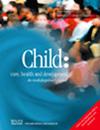Effects of SAFE Early Intervention Approach in the First Months of Life in Infants at Risk: A Randomized Controlled Study
Abstract
Background
This study aimed to examine the effects of the SAFE early intervention approach (Sensory strategies, Activity-based motor training, Family collaboration, and Environmental Enrichment), developed for at-risk infants, on motor, cognitive, language development, and sensory processing skills in the first 3 months of life.
Methods
Twenty-six infants with a corrected age of 42 weeks were included in the study, and the infants were randomly distributed to the treatment and control groups. The SAFE early intervention approach was applied to 14 infants in the treatment group, and the Neurodevelopmental Treatment-based home programme was applied to 12 infants in the control group. All infants included in the study were evaluated at the corrected 42nd week before the intervention and at the corrected 12th week after the intervention by an evaluator blinded to the treatment. Bayley Scales of Infant and Toddler Development III (Bayley-III) to evaluate cognitive and motor development; Test of Infant Motor Performance (TIMP) to evaluate neuromotor development; Infant/Toddler Sensory Profile 2 (ITSP 2) to assess sensory processing t was used. The Infant/Toddler HOME Inventory was used to evaluate the home environment.
Results
The interaction effects (time × group) revealed significant advantages for the SAFE early intervention group, evidenced by higher scores in the Bayley-III motor composite, TIMP elicited and HOME total assessments (p < 0.05). However, the interaction effects (time × group) showed no differences between the groups in the Bayley-III cognitive and language composite scores, as well as the TIMP observed and TIMP total scores (p > 0.05). The main effect for time was significant in all parameters (p < 0.05). Similarly, the main impact for groups was substantial in all evaluation parameters except the Bayley-III language composite score and TIMP observed score (p < 0.05). The interaction effects (time × group) demonstrated significant differences in favour of the SAFE early intervention group for the general processing score, auditory processing score, tactile processing score and total score of the ITSP 2 (p < 0.05).
Conclusions
The SAFE early intervention approach enhanced motor and sensory outcomes and provided a more enriched home environment than the NDT-based home programme. It was concluded that neurodevelopmental improvement will be achieved with the SAFE early intervention approach in the early period in at-risk infants.
Trial Registration: NCT06361134


 求助内容:
求助内容: 应助结果提醒方式:
应助结果提醒方式:


